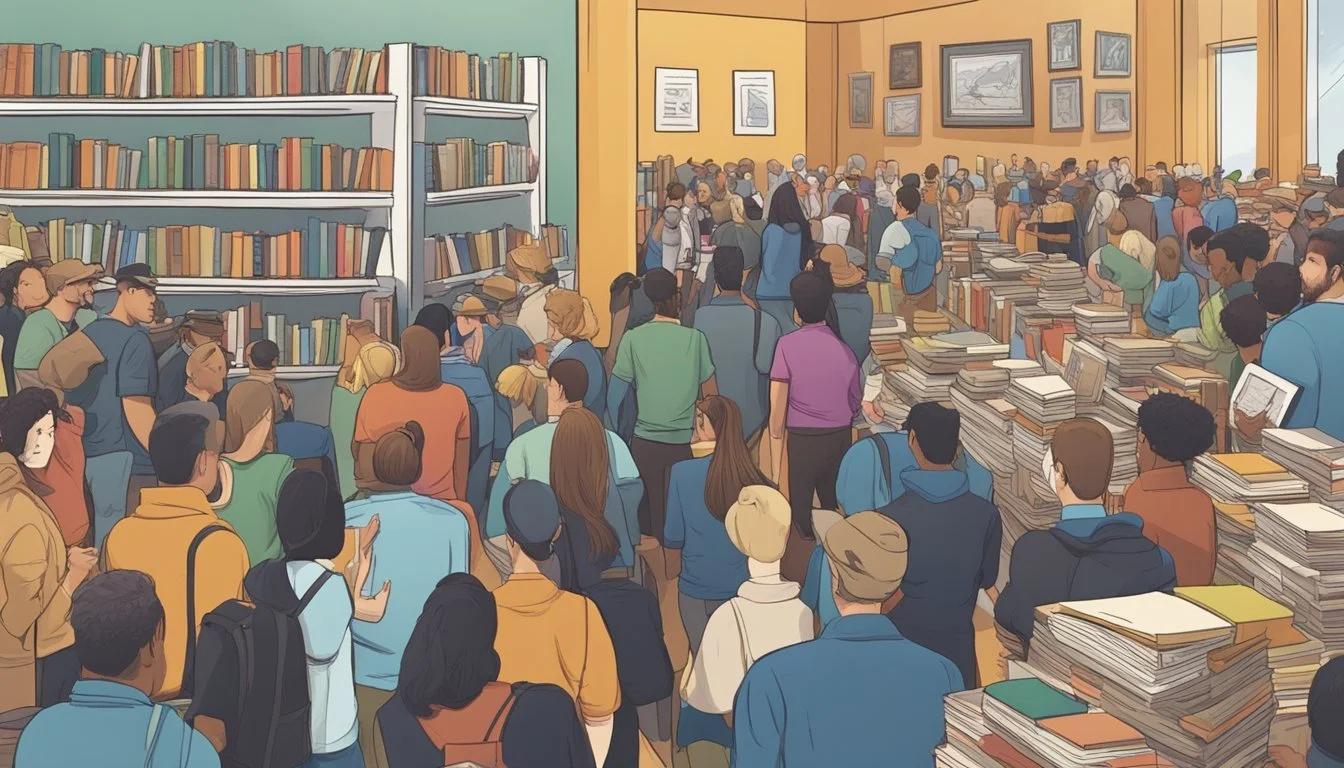Luis Elizondo Meets Fans at Explosive Book Signing Event
UFO Investigator Meets Fans in NYC
Luis Elizondo, the former head of the Pentagon's Advanced Aerospace Threat Identification Program (AATIP), is set to hold a book signing event for his highly anticipated work "Imminent: Inside the Pentagon's Hunt for UFOs." Published by William Morrow, this revelatory account promises to shed light on the government's long-standing involvement in UFO research.
Elizondo's book offers readers an unprecedented glimpse into the secretive world of government UFO investigations, drawing from his firsthand experiences at the helm of AATIP. The signing event presents a unique opportunity for enthusiasts and skeptics alike to engage with one of the most prominent figures in modern UFO research.
Beyond recounting his time at the Pentagon, Elizondo's book serves as a call to action, urging readers to confront humanity's greatest existential questions. As interest in Unidentified Anomalous Phenomena (UAP) continues to grow, this book signing event is poised to attract significant attention from those eager to learn more about the government's covert UFO program and its implications for society.
About Luis 'Lue' Elizondo
Luis 'Lue' Elizondo is a former senior intelligence official who gained prominence for his work on unidentified aerial phenomena. His career spans military service, counterintelligence, and UFO research.
Career in Intelligence and National Security
Elizondo served as a counterintelligence special agent for the U.S. Army. He later worked for the Department of Defense, overseeing counterespionage and counterterrorism investigations worldwide.
His expertise led him to the Office of the Director of National Intelligence and the Office of the National Counterintelligence Executive. In these roles, Elizondo managed highly sensitive operations at various military installations.
Role in AATIP and UFO Research
In 2010, Elizondo became the director of the Advanced Aerospace Threat Identification Program (AATIP). This classified U.S. government program investigated unidentified aerial phenomena.
Under his leadership, AATIP collected and analyzed data on unexplained aerial sightings. Elizondo's work brought attention to the potential national security implications of these phenomena.
He resigned from the Pentagon in 2017, citing secrecy and internal opposition to the program. Since then, he has been vocal about the need for transparency regarding UFO research.
Academic Background and Early Life
Elizondo attended the University of Miami, where he studied microbiology and immunology. This scientific background would later inform his analytical approach to investigating unexplained phenomena.
Born into a family with a military background, Elizondo developed an early interest in national security matters. His upbringing and education laid the foundation for his future career in intelligence and unconventional research.
The Phenomenon of UFOs
UFOs have captivated public interest and sparked government investigations for decades. The subject raises profound questions about national security, technological capabilities, and humanity's place in the universe.
Encounters and Evidence
UFO sightings span the globe, with reports from military personnel, pilots, and civilians. Radar data, video footage, and eyewitness accounts form the bulk of evidence. The Pentagon's Advanced Aerospace Threat Identification Program (AATIP) collected and analyzed reports of Unidentified Anomalous Phenomena (UAP).
Notable incidents include the 2004 USS Nimitz encounter, where Navy pilots observed and recorded an object with extraordinary flight characteristics. Such events challenge our understanding of physics and aeronautics.
Threats to Security and Safety
UFOs pose potential risks to air safety and national security. Unidentified objects entering restricted airspace raise concerns about foreign surveillance or advanced adversary technology.
The military and intelligence communities take these threats seriously. UFO incursions near nuclear facilities and military installations have been documented, prompting increased scrutiny and investigation.
Pilots report near-misses with unidentified objects, highlighting safety concerns for commercial and military aviation.
Public Perception and Government Disclosure
Public interest in UFOs has grown, fueled by media coverage and declassified government reports. The U.S. government's stance has shifted from dismissal to acknowledgment of the phenomenon's reality.
Recent years have seen increased transparency. The Pentagon released UAP videos and reports to Congress, admitting some encounters defy conventional explanation.
This openness has reignited debate about the nature of UFOs and their implications for science, technology, and society. The American people increasingly demand answers about what their government knows.
Global Context of UFO Intrigue
UFO sightings and investigations have sparked worldwide interest and debate. Governments and organizations across the globe have approached the phenomenon with varying degrees of openness and skepticism.
Inter-governmental Collaboration
Several countries have engaged in cooperative efforts to study UFOs. The United States has shared data with allies like the United Kingdom and Australia. France's GEIPAN program collaborates with other European nations to analyze unexplained aerospace phenomena.
South Korea and Japan have established information-sharing protocols for UFO reports. Latin American countries, including Chile and Peru, have created official UFO investigation units. These organizations often exchange findings and methodologies.
The United Nations has discussed the topic in informal sessions, though no official resolutions have been passed. Some Middle Eastern nations have shown interest in the subject, with the United Arab Emirates investing in space research that may overlap with UFO studies.
Comparative Analysis of UFO Cases Worldwide
UFO reports show both similarities and differences across regions. Triangular craft sightings are common in North America and Europe. Spherical objects are frequently reported in Latin America and the Caribbean.
Asian countries often document luminous phenomena. Australia and New Zealand have a history of close encounter reports. African nations have fewer official records but rich oral traditions of unexplained aerial events.
Military encounters with UFOs have been reported by various countries. The United States Navy's videos of unidentified aerial phenomena gained global attention. Similar incidents have been documented by pilots in Russia, Iran, and Brazil.
Civilian cases also show patterns. Mass sightings have occurred in major cities worldwide, from Phoenix to Mexico City to Shanghai. Rural encounters often involve alleged landings or interactions with beings.
Inside the Book Signing Event
Luis Elizondo's book signing event for "Imminent" promises exclusive insights into unexplained phenomena and extraterrestrial encounters. Readers can expect an engaging atmosphere with opportunities for direct author interaction and access to special editions of the book.
Anticipated Discussions
Luis Elizondo will likely share his experiences from the Pentagon's UAP program. He may discuss classified information now made public and offer his perspective on recent government disclosures. Attendees can anticipate hearing about unexplained aerial encounters and their potential implications for aviation safety.
Elizondo might address the scientific approach to studying these phenomena. He could delve into the advanced sensor technologies used to track and analyze UAPs. The author may also touch on the broader implications for our understanding of the universe and humanity's place in it.
Questions from readers about extraterrestrial life and its potential impact on society may arise. Elizondo's responses could provide valuable insights into how governments are preparing for possible contact scenarios.
Venue and Atmosphere
The book signing event is scheduled for August 27, 2024, at 7:00 PM EDT. It will be a virtual event, allowing readers to join from anywhere. This format enables a wider audience to participate and interact with Elizondo.
The online platform will likely feature a chat function for attendees to submit questions. A moderator may select and present these questions to Elizondo during a Q&A session. This setup encourages direct author-reader interaction, creating an engaging and intimate atmosphere despite the virtual setting.
Visual elements such as slides or video clips might be incorporated to enhance Elizondo's presentation. These could include declassified footage or images related to UAP encounters discussed in the book.
Book Availability and Special Editions
Signed copies of "Imminent" are available for pre-order through designated websites. These autographed editions offer readers a unique collector's item and a personal connection to the author.
Special editions of the book may include:
Hardcover with dust jacket
Limited edition with additional content
Bundled packages with exclusive merchandise
Early purchasers might receive bonus materials such as:
Access to a private Q&A session with Elizondo
Digital companion guide with extra research notes
Commemorative bookmark or art print
Readers attending the virtual signing can expect information on how to obtain their signed copies. The event may also offer a limited-time discount or special offer for attendees, encouraging immediate purchases.
Further Implications and Future Research
Luis Elizondo's book signing has sparked renewed interest in UFO research. This has implications for scientific inquiry, government policy, and technological advancements in space exploration.
Scientific Inquiries and Hypotheses
Scientists are developing new research protocols to study UFO phenomena. Advanced sensor technologies and data analysis methods are being employed to gather and interpret evidence. Astrophysicists are proposing hypotheses about potential extraterrestrial propulsion systems and energy sources.
Multidisciplinary teams are exploring the possibility of non-Earth origin materials. Quantum physics theories are being applied to explain reported UFO behaviors that seem to defy known laws of physics.
Governmental Stance on Future UFO Reports
Government agencies are reassessing their approach to UFO sightings. New reporting systems are being implemented to standardize data collection across military branches. Transparency initiatives aim to declassify and share more information with the public.
International cooperation is increasing, with countries sharing UFO-related intelligence. Policy makers are drafting guidelines for potential extraterrestrial contact scenarios. Military strategies are being updated to account for unidentified aerial phenomena.
Technological Advances and Space Research
Space agencies are integrating UFO research into their exploration programs. New telescope designs aim to detect and track anomalous objects in Earth's orbit. Satellite networks are being enhanced to provide better coverage of atmospheric events.
Propulsion research is exploring theoretical concepts inspired by reported UFO capabilities. Advances in materials science may lead to breakthroughs in spacecraft design. AI and machine learning algorithms are being developed to analyze vast amounts of space data for anomalies.
Afterword: A Call to Action
Luis Elizondo's book signing event serves as a platform to inspire action and engagement from readers. His experiences and insights highlight the need for public involvement in matters of national security and unexplained phenomena.
Mobilizing Public Interest
Elizondo emphasizes the importance of an informed citizenry in addressing UAP-related issues. He encourages readers to educate themselves on the topic through reputable sources and scientific literature. Public engagement can take various forms:
• Attending lectures and seminars • Participating in online forums and discussions • Supporting research initiatives
By fostering a community of informed individuals, Elizondo believes society can better address the challenges posed by UAPs.
Advocating for Governmental Accountability
The author stresses the need for increased transparency from government agencies regarding UAP investigations. He outlines specific steps citizens can take:
Contacting elected representatives
Supporting legislation for declassification of UAP-related documents
Demanding regular public briefings on UAP research progress
Elizondo argues that public pressure is crucial in ensuring continued governmental focus on this issue.
The Role of Individuals in National Security
Elizondo draws from his background in espionage and counterterrorism to highlight how ordinary citizens can contribute to national security. He suggests:
Developing critical thinking skills to identify misinformation
Reporting suspicious activities to appropriate authorities
Pursuing educational opportunities in relevant fields
The author emphasizes that national security is a collective responsibility, requiring vigilance and active participation from all citizens.





